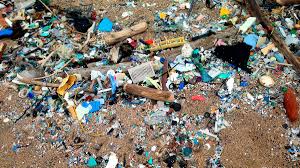From an Article by Julia Conley, Common Dreams, May 11, 2023
“As plastic pollution saturates our planet and our bodies, the Biden administration should take every reasonable step to protect our environment and public health,” said Rep. Lloyd Doggett.
Citing extensive research which has shown recently that microplastics are ubiquitous in the environment, more than 70 U.S. House members on Friday wrote to the Environmental Protection Agency to demand stronger regulation of the microscopic particles that are used in everyday household items and have been linked to respiratory diseases and cancers.
Rep. Lloyd Doggett (D-Texas) led lawmakers including Reps. Pramila Jayapal (D-Wash.), Mark Pocan (D-Wis.), and Barbara Lee (D-Calif.) in writing the letter, which notes that under the Clean Water Act, the EPA can and should “use its existing statutory authorities to address the growing prevalence of microplastic pollution” across the country.
Currently, the lawmakers said, it is largely being left up to individual states to decide whether to regulate microplastics, leading to “troubling disparities… regarding basic protections.”
In Doggett’s home state, the Texas Commission on Environmental Quality last year “quickly abandoned” a proposal to require “chemical companies to have internal processes restricting accidental releases of plastic pollution,” while California residents are benefiting from a statewide effort led by the California Ocean Protection Council to reduce microplastics in marine environments.
“Federal action should encourage high standards to mitigate microplastics in natural environments, which can ultimately make their way into the food we eat, the water we drink, and the air we breathe,” wrote the lawmakers.
The letter points to a 2020 study which found that scientists discovered microplastic pollution in some of the world’s most remote places, including Mount Everest, and research from 2021 which suggested the average adult ingests 320,000 microplastics each year.
As Common Dreams reported last year, a team of researchers in the U.K. found tiny microplastic particles lodged in the lungs of 11 out of 13 patients at a hospital, with the most common microplastic found being polypropylene—commonly used in plastic packaging, textiles, and kitchen utensils.
A draft report on microfiber pollution from the EPA and the National Oceanic and Atmospheric Administration (NOAA) found that microplastics “have the potential to impact human reproductive, respiratory, digestive, nervous, and urinary systems,” noted Doggett and the other lawmakers on Friday.
“Plastic pollution is not just affecting our oceans and marine life—it’s flowing in our bloodstreams and lingering on nearly every object we touch,” said Doggett in a statement. “Regulating microplastics as hazardous waste will protect our health and our environment.”
The lawmakers wrote that they are “encouraged” by the EPA and NOAA’s draft report and accompanying federal plan for preventing microfiber pollution, but called on the agency to take steps under the Clean Water Act — whose “whole purpose is to eliminate the discharge of pollutants into our waters” — to mitigate microplastics in the environment.
The letter calls on EPA Administrator Michael Regan to:
>> Issue national drinking water regulations for microplastics modeled on proposed rules for per-and polyfluoroalkyl substances (PFAS), using the Safe Drinking Water Act regulatory process to establish enforceable limits on the number of microplastics in water;
>> Officially recognize microplastics as hazardous and toxic materials, rather than solid waste, so they can be regulated under the Resource Conservation and Recovery Act;
>> Establish effluent limitations for industrial and general stormwater runoff to contain zero microplastic;
>> Publish the final version of the EPA/NOAA joint report on microfiber pollution and pursue the recommended actions with an urgent timeline; and
>> Increase research and outreach within the EPA’s Trash Free Waters program to improve our understanding of microplastics.
“Plastics are riddled with toxic chemicals, but their tiny size allows microplastics to infiltrate our environment, our food chain, and our bodies unnoticed,” said Anja Brandon, associate director of U.S. plastics policy at Ocean Conservancy. “Who doesn’t wish we had taken action on lead, DDT, or PFAS earlier? We need to be treating microplastics the same way we treat other pollutants.”
“These are actions that the EPA can and must take now,” said Brandon, “to address this growing threat.”
>>>>>>>……………………>>>>>>>…………………>>>>>>>
See Also: Microplastics Research, US EPA, April 14, 2023
Plastics have become ubiquitous in natural and built environments which has caused concern regarding potential harms to human and aquatic life. Microplastics (plastic particles ranging in size from 5 mm to 1 nm) and nanoplastics (plastic particles smaller than 1 nm) have been found in every ecosystem on the planet from the Antarctic tundra to tropical coral reefs. The wide range of particle sizes, densities, and compositions pose a challenge for researchers because there is not a single method that can be used to characterize the wide variety of micro and nanoplastic particles. There is a pressing need to develop and standardize collection, extraction, quantification, and identification methods for micro/nanoplastics to improve reliability, consistency and comparability across studies.
EPA research addresses plastic pollution in the aquatic environment by establishing reliable and reproducible approaches for sampling micro/nanoplastics, separating plastics from organic and inorganic interferences found in environmental samples, and extracting plastics without harsh chemicals or heat that further degrade plastic. Using state-of-art analytical chemistry instrumentation, researchers are working to determine appropriate analytical methods to characterize and quantify total microplastics in sediment and water samples, as well as the different types of plastic polymers. This research helps inform recommendations for best practices and standardized methodologies to characterize and assess the extent of micro and nanoplastics pollution in water.

